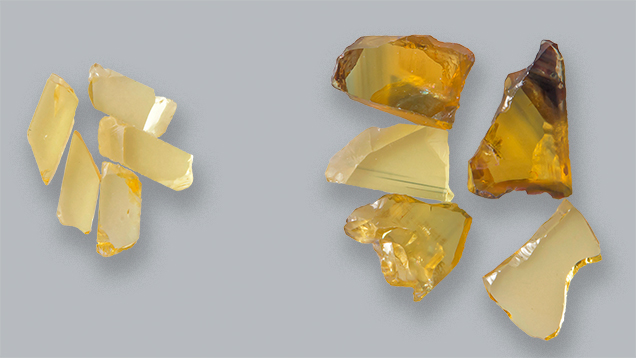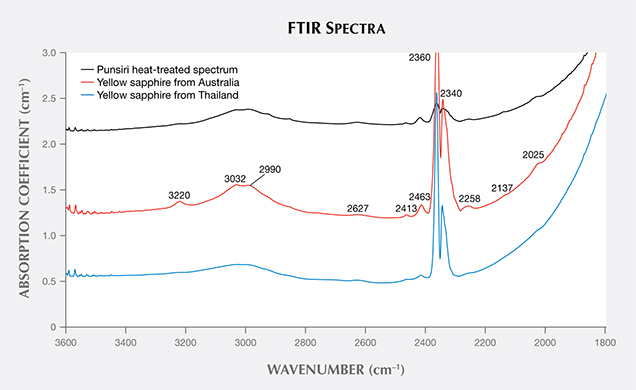“Punsiri”-type FTIR Spectral Features in Natural Yellow Sapphires

Recently, a yellow sapphire from Chanthaburi, Thailand, showed a spectrum associated with “Punsiri” high-temperature heat treatment of blue sapphire. In response, GIA’s Bangkok lab performed FTIR spectroscopy on 38 untreated natural basalt-related yellow sapphires (figure 1). Twenty-two of the samples were from the Anakie Gem Fields area in Queensland, Australia, and the remaining 16 from the Khao Ploi Waen area of Chanthaburi. All were collected from the mines by GIA field gemologists.
Standard gemological testing of the Australian sapphires showed RI (nω) = 1.774 ± 0.001 and RI (ne) = 1.765 ± 0.001, with a birefringence of 0.009 ± 0.001. For the Thai sapphires, RI (nω) = 1.773 ± 0.001 and RI (ne) = 1.764 ± 0.001, with a birefringence of 0.009 ± 0.001. All the stones were inert under long-wave and short-wave UV radiation due to their very high iron content.
Most of the Australian sapphires were yellow, whereas the Thai sapphires appeared greenish yellow. Only homogeneous yellow areas were analyzed by FTIR. Many of the stones (about 45% of the Australian stones and about 38% of the Thai stones) showed a characteristic Punsiri FTIR spectrum, consisting of a multiple band structure positioned around 2000−3300 cm−1 with peaks at 2025, 2137, 2258, 2413, 2463, 2627, 2990, 3032, and 3220 cm−1 (figure 2). These features have traditionally been considered indicative of heat treatment, since this pattern has only been observed in Punsiri-type heated blue sapphires (G. DuToit et al., “Beryllium treated blue sapphires: continuing market observations and update including the emergence of larger size stones,” GIA Research News, June 2009) that display multiband FTIR spectra around 3000 cm−1. This FTIR feature is attributed to the stretching vibration of the OH bond formed by the incorporation of hydrogen and host oxide ion in a publication about “magnesium-doped α-alumina” grown by the Verneuil method, where the IR absorption results are affected by the incorporation of hydrogen into a Mg-doped α-alumina (N. Fukatsu et al., “Incorporation of hydrogen into magnesium-doped α-alumina,” Solid State Ionics, Vol. 162, 2003, pp. 147−159). Since the samples were all collected in the field, it is extremely interesting to document that Punsiri-type FTIR spectra may be found in natural unheated yellow sapphires.

LA-ICP-MS showed trace elements of Mg, Ti, V, and Ga, with very high ppm levels of Fe (3000 ppma on average). Mg content (about 23 ppma) was higher than Ti content (approximately 16 ppma); thus, blue coloration is not seen in these stones. Since Be was not detected, there are no concerns about beryllium diffusion treatment, which is not surprising since these specimens were collected in the field.
It appears as though the incorporation of hydrogen in corundum may form characteristic Punsiri-like FTIR features. Since these features were observed in natural basalt-related yellow sapphires from Australia and Thailand, careful consideration must be exercised when using FTIR to identify heat treatment in corundum.



